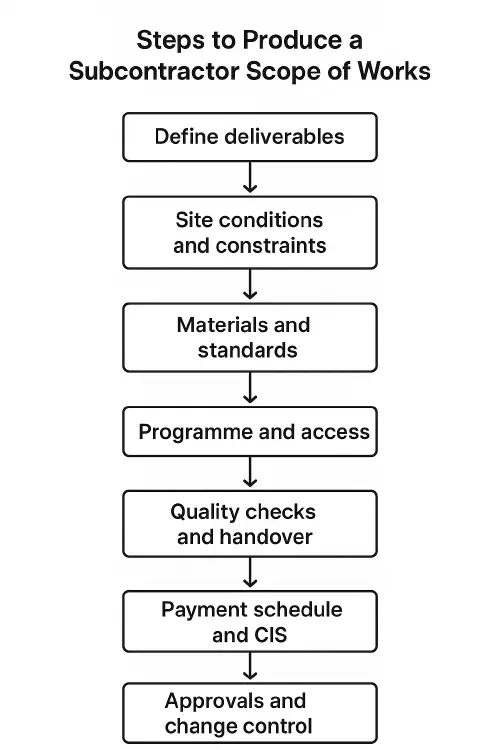
Templates & Resources
Subcontractor scope of works template: free Word example, CIS payment schedule and what to include
TrainAR Team
1 month ago
6 min read
Subcontractor scope of works template: free Word example, CIS payment schedule and what to include
Category: Templates & Resources • Niche: Contracts admin, CIS, subcontractors

Site office desk with a Scope of Works checklist, drawings and PPE
Contents
- Who this is for
- Quick answer
- Copy-paste Scope of Works template
- How to fill it in step by step
- Example clauses you can reuse
- CIS payment schedule and records
- Exclusions and assumptions
- Approvals, changes and variations
- Quality checks, tests and handover
- Flowchart: writing a solid scope
- Common mistakes to avoid
- Handy tools and links
- FAQ
Who this is for
- Small to mid-size contractors and subcontractors who want fewer disputes and faster payments.
- Site managers who need clear scopes to brief trades.
- Anyone working under JCT or similar terms where unclear scope causes variations and delays. For background on variations, see our guide Variation order in construction: simple JCT procedure, pricing and templates that get paid.
Quick answer
A subcontractor Scope of Works should be short and specific. It must list deliverables, standards, materials, programme, access rules, quality checks, payment stages and what is excluded. Include a CIS-ready payment schedule and a simple change-control note so extra works get authorised before doing them. Keep it to two to four pages. Use the template below and attach drawings and specs.
Copy-paste Scope of Works template
Copy this into Word or Google Docs and fill the brackets.
Document: Subcontractor Scope of Works
Project: [Project name and address]
Trade package: [e.g. First-fix electrics to Unit A]
Issue date: [dd/mm/yyyy]
Revision: [0]
1. Description and deliverables
- Summary: [One paragraph on what is included]
- Deliverables list:
- [e.g. Supply and install new 18-way consumer unit]
- [e.g. Run all first-fix cabling to drawings E-101 to E-104]
- [e.g. Provide test certificates]
2. Drawings, specs and standards
- Drawings: [list drawing numbers and latest revisions]
- Specifications: [e.g. NBS section, supplier technical datasheets]
- Standards: [e.g. BS 7671 18th Edition, manufacturer instructions]
3. Materials and workmanship
- Materials by: [Subcontractor or Main Contractor]
- Approved brands: [list or “equivalent with approval”]
- Workmanship: to [e.g. BS, manufacturer, Building Regs] and good trade practice
4. Site conditions and constraints
- Access hours: [e.g. 07:30 to 17:00 Mon–Fri]
- Interfaces: [e.g. coordinate with dryliners week 42]
- Permits: [e.g. hot works, isolations, RAMS approved prior to start]
5. Programme and sequencing
- Start date: [dd/mm/yyyy]
- Duration: [e.g. 10 working days]
- Dependencies: [e.g. after walls are lined, before ceilings closed]
6. Quality checks and testing
- Inspections: [e.g. first fix inspection before cover-up]
- Tests: [e.g. dead tests per BS 7671]
- Records: [photo records uploaded to shared folder]
7. Handover and close-out
- O&M: [as-built drawings, certs, warranties]
- Snagging: [joint snag list, target 5-day closeout]
8. Payment schedule and CIS
- Valuation stages: [e.g. 30 percent first fix, 60 percent second fix, 10 percent test and handover]
- Evidence: [photos, signed stage checklist]
- CIS: [confirm CIS status and UTR; deductions as per HMRC]
- Retention: [e.g. 5 percent, half released at Practical Completion, half at end of defects]
9. Exclusions and assumptions
- Exclusions: [list clearly]
- Assumptions: [list any assumed conditions]
10. Approvals and change control
- Site instructions: [must be in writing by named person]
- Variations: [priced and agreed before work where practical]
Sign-off
- Issued by: [name, role, company]
- Accepted by: [name, role, company]
- Date: [dd/mm/yyyy]
How to fill it in step by step
- Define deliverables. List the actual outputs, not just tasks. For example “Install 10 fire doors FD30 with closers and seals” rather than “Fit fire doors.”
- Attach drawings and specs. Reference drawing numbers and revisions. If you change them later, reissue the scope with a new revision number.
- Materials and standards. State who supplies what. Quote UK standards where relevant, for example BS 7671 for electricals or manufacturer guidance.
- Site conditions. Note access hours, protection, working in live buildings, and required permits. If CDM applies, align with your CPP and RAMS. HSE’s CDM 2015 overview is here: HSE CDM 2015.
- Programme. Give simple dates and dependencies so other trades can plan.
- Quality and testing. Say what will be inspected and tested, and what evidence you will keep.
- Payment stages and CIS. Break payment into simple milestones with evidence, and confirm CIS details. HMRC guidance: Construction Industry Scheme.
- Exclusions and assumptions. This is your safety valve. Be clear and fair.
- Approvals and changes. Name who can authorise extras. Link to your variation process. See our JCT application for payment guide for notice timing context.
Example clauses you can reuse
- Materials by Main Contractor: “MC to supply tiles, adhesive and trims to site 48 hours before tiler start. Tiler to confirm quantities one week prior.”
- Equivalent products: “Equivalent products may be proposed where equal or better performance can be demonstrated in writing and approved before order.”
- Protection: “Protect adjacent finishes and client areas at all times. Any damage made good at subcontractor cost.”
- Live building: “Work to be sequenced to keep fire exits open and noise below 70 dB during trading hours.”
- Test evidence: “Submit BS test results and photo evidence to the shared drive within 24 hours of test.”
CIS payment schedule and records
- Confirm CIS status at onboarding and keep UTR on file. Our Subcontractor onboarding checklist covers right to work, induction and documents.
- Keep simple stage valuations. For example, first fix 30 percent, second fix 60 percent, completion 10 percent with signed stage checklists and photos.
- Apply retention and defect period in the scope so everyone is aligned.
- Keep records in a shared folder with the scope, drawings, RAMS and photos. If you need a snagging structure, use our Snagging list template.
Exclusions and assumptions
Examples to consider:
- Making good by others except for own fixings
- Out-of-hours work excluded
- Access equipment above [3 m] excluded unless stated
- Power and water by Main Contractor
- Unforeseen asbestos removal excluded. If relevant, see HSE guidance via your asbestos surveyor.
Approvals, changes and variations
- Name the person who can authorise scope changes on site. If they change, reissue the scope with a new revision.
- Price and agree variations before doing the work where possible. If urgent, get a written instruction then follow up with price within an agreed timeframe.
- If you are under JCT, align with the instruction and valuation process. JCT resources: JCT Ltd.
Quality checks, tests and handover
- Inspections before cover up are key. Agree a simple checklist. For wider context on closeout, see our Right to work checks on construction sites for ID and induction expectations.
- Handover pack should include as-built drawings, certificates, warranties and photos of critical details.
Flowchart: writing a solid scope

Flowchart steps to create a subcontractor scope of works
Common mistakes to avoid
- Vague wording like “do electrics” with no deliverables
- No drawing numbers or revisions referenced
- Not stating who supplies which materials
- No payment stages or evidence required
- Missing exclusions so you inherit extra work for free
- Change approvals not named, leading to unpaid extras
Handy tools and links
- What a scope is in UK terms: Designing Buildings Wiki
- Domestic clients guidance: LABC Front Door on scope of work
- RICS professional guidance on subcontracting: RICS Subcontracting PDF
- HMRC CIS overview: gov.uk CIS
- HSE CDM 2015 overview: HSE CDM